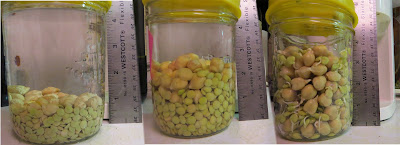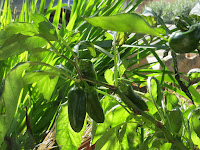I love almost all cheeses. Not fond of blue cheese but I know many folks are so choose your preferred cheese for these crackers :-)
The other day when it was raining/pouring cats and dogs* I was having cabin fever and resorted to my go-to -- cooking!
I had wanted to try a homemade Cheeze-It recipe for a while. I love them, also Cheetos, and indulge in either on a rare or limited basis because of all the chemical additions.
Right off the top I have to tell you this not low calorie or low fat. I use real organic butter a really nice local cheese and unbleached white whole wheat flour but they are really great tasting! Pictured are the finished crackers - the empty spot is the one I tasted :-)
A couple of tips. Use a coarse grater for the cheese and the butter (frozen). Grating frozen butter is far easier than trying to incorporate cubes etc. into a dough. I saw that tip on a recipe and grabbed it!
I used a great cheese from Arizona Farms (you can use any firm Cheddar or Cheddar like cheese. I like white cheddar. Yellow cheddar have annatto to color the cheese - a practice begun by Kraft because they did not think the housewife wanted white cheese. Annatto is natural and derived from a plant, but still I wanted natural. I bowed to the idea of a bit of color by adding a tiny amount of Paprika as the white whole wheat flour I used also was pale.
Also use your food processor or mixer with a paddle. I tried my mixer with dough hooks and all it did was spin the cheese, butter and flour around into well floured strips. I wound up dumping everything into the processor and it came together lickity-split.
If you go looking for Cheeze-It recipes you will see variations on chill, flour, roll - I like the idea of placing the dough between 2 pieces of wax paper and just rolling it out. Saves adding extra flour (sometimes not a good thing) and cleaning your rolling pin of dough.
Roll, cut with pizza cutter - a pastry wheel gives a more authentic look if you have it. I cut off the odd edges, and re-rolled to use up every bit of the dough. You can probably see from the un-even sizes of the "squares" that my oft-repeated comment about myself (I can't cut a straight line with a ruler) applies. But they still backed up okay. :-)
Once you have them cut into squares place on a parchment lined cookie sheet, or no-stick cookie sheet, separated slightly. Poke with a fork or chopstick. This makes it look more like the commercial one AND prevents them turning too puffy - unless you like puffy. :-) They are supposed to puff slightly because of the butter flour combo.
I am really pleased with my first try at making these. I erred on the side of using unsalted butter. I would recommend using salted, keep the extra salt in the recipe, as these are meant to be salty tasting, just not AS salted as the commercial variety.
Deane loves peanut and really is enjoying these with peanut butter. I like them out of hand. They will be good on stews, soups or even as croutons on salads.
I may try a way to reduce the calories. This batch came in at 1398 Calories, 51.13 grams of Protein and 13.98 Grams of Fiber for 67 crackers. I will try something like substituting some of the butter for parmesan cheese. 1 ounce/tablespoon of butter or Parmesan have about the same amount of calories, but the Cheese will add 8 grams of protein for each ounce. With the full fat cheddar, if I sub 3 ounces of Par for the butter, it would add 24 grams of protein to the batch. May try this and post how it turns out.
I purchased the cheese from Tom Garrett one of the vendors at the Mesa Community Farmers Markets and he had to tell me about the new Arizona Farms Cheese he was carrying: "Garlic, Black Pepper, White Cheddar" (he carries cheese curds and a variety of other cheeses). I immediately bought it. Used it to make a cheeseball at the holidays and then the rest for this recipe. FYI Tom sells the cheeses, avocado oil and Maple Syrup at other markets too.
My Homemade Cheeze-Its
1 1/2 cups of coarsely shredded cheese, Cheddar or other firm cheese (natural or organic)
4 tablespoons / 4 ounces (1/2 stick) of frozen butter, coarsely shredded (organic)
3/4 cup of white whole wheat flour (I used King Arthur)
1/4 teaspoon of sea salt + more for sprinkling
1/8 teaspoon of paprika
1-3 tablespoons of ice water
Preheat the oven to 350. Prepare your cookie sheet with parchment paper if using.
Toss the cheese and butter together lightly just to mix in. Stir flour, salt and paprika together. Place all in a food processor and pulse. It will form a pebbly texture. With the processor running, dribble in 1 tablespoon of ice water at a time, slowly and watch. The dough will come together quickly and should hold together like a soft clay when ready. Don't over use the water.
Roll out between to pieces of wax paper to an 1/8 or 1/4 inch thickness. How thick you make is your choice and will only alter overall baking time.
Cut into squares with a pizza or pastry wheel. Poke with a fork or chopstick before or after you place on the cookie sheet. Bake for 8-14 minutes and WATCH them. They should just brown ever so slightly around the edges, puff slightly and look dry. Remove, cool, eat! Store away from moisture. Enjoy!
If you enjoy my recipes, check out my newest cookbook. Available in print or ebook PDF at my Publisher's site. Amazon, Barnes & Noble and Changing Hands should have it in about 4 weeks.
My first cookbook "101+ Recipes From The Herb Lady" is filled with herb inspired recipes focusing on using herbs and spices first to bring the full flavor of the dish out before adding salt and fats.
. . .
*The origin of pouring/raining cats and dogs is believed to relate back to the early centuries when roofs were made of thatch and straw and easily accessible by the family's cats or dogs because of the warmth of the straw and heat from the fires inside. In a downpour the animals would slide off the roof e.g., raining cats and dogs.
I hope your weekend is great!
-- Catherine, The Herb Lady
http://www.herbs2u.net/home.html
If you enjoyed this post, subscribe in the upper side bar link, to get all my posts!
Disclaimer: Clicking on links on this blog may earn me a small commission if you purchase something. Your price does not change.

















































